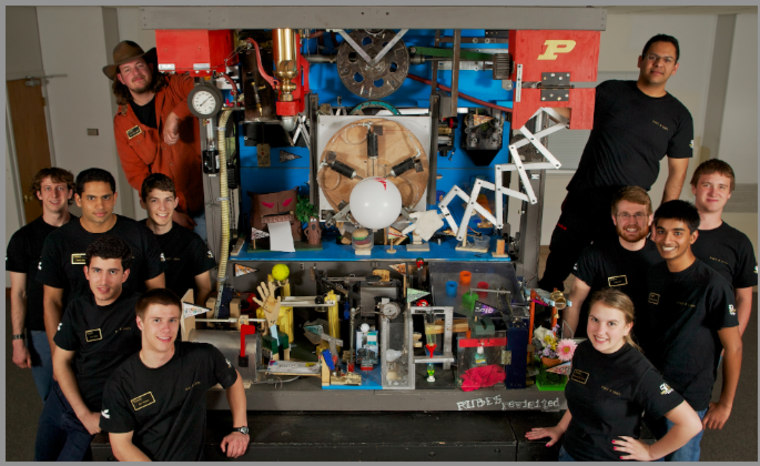A team of engineers at Purdue University has set the world record for "Largest functional Rube Goldberg machine" with a mind-boggling contraption that takes 300 steps to inflate and pop a balloon.
In doing so, they bested themselves, as they had the previous record, with 244 steps.
While they've captured the current record as set by the World Records Academy (which has more than 2,300 records listed online and more than 250,000 in an offline database), they're still waiting on verification from Guinness World Records, which is a lengthy process. (They achieved the Guiness in March 2011.)
They broke the record on March 31 at the National Rube Goldberg Machine Competition, after six months and thousands of attempts for the individual components. The machine had its first perfect run on March 29 and the video below records that.
I wish the video guys who captured the action had been able to zoom in a bit more, because it's a dizzying array in 2:17 minutes to behold -- especially with the team cheering on in the background. But I did catch some things on repeated viewings that made me chuckle, and yes, even gasp (in awe and appreciation that so much could go into such a simple task).
It had the usual water flowing through funnels and ball rolls, but it also added some perks, like toasting a piece of bread, a mini-putt on a mini-golf hole (upside down, no less!) and a watermill. But each module -- that is task -- was so clever in itself, that to see it choreographed as a whole is a real treat.
The Purdue Society of Professional Engineers' Rube Goldberg Team president Zach Umperovitch told us 14 members worked on this project over a span of six months -- for a total of 5,000 hours. He told msnbc.com they weren't even aiming to break the record.
"The theme that was decided on was to include every single task ever designated by the RGI contest. So ie: 25 previous tasks = 25 modules. A normal machine we build has 10-14 modules. The necessity to include 25 modules is what determined the number of steps. NEVER, and I repeat NEVER do I ever count the steps until the final minute. The number of steps does not matter at all when building these machines, rather displaying our creating and mechanical knowledge to solve the task in the most comical/whimsical way is what we strive for."
But the hardest part, he admitted, was the final module, which was "a collective design by our seasoned members who wanted to experiment with a technology not previously seen on any Rube Goldberg machine."
Creating a boiler to power a steam locomotive drive system to power what is essentially the same design as an airplane engine (ie: radial pump wheel) all to blow up the balloon...well, we are college students. None of us have ever done anything quite that intricate ever! Collectively, around 600 man hours were dedicated to that module alone, and the final product is actually the fifth version.
Umperovitch is finishing his first year of grad school studying geophysics, after attending Purdue as an undergraduate for five years, earning a bachelors' degrees in Geology and Geophysics. The rest of the team are all engineering undergrads at Purdue.
The team's next project is just as ambitious, if not more. They are building a life-sized Rube Goldberg machine at Peddler's Village, Penn. in order to promote the Rube Goldberg Challenge.
They also have in the works "preparations for numerous presentations around the country." But as for what could top this record-breaking machine, Umperovitch was more coy: "You'll just have to wait and see."
Check out Technolog on Facebook , and on Twitter, follow Athima Chansanchai , who is also trying to keep her head above water in the Google+ stream.
